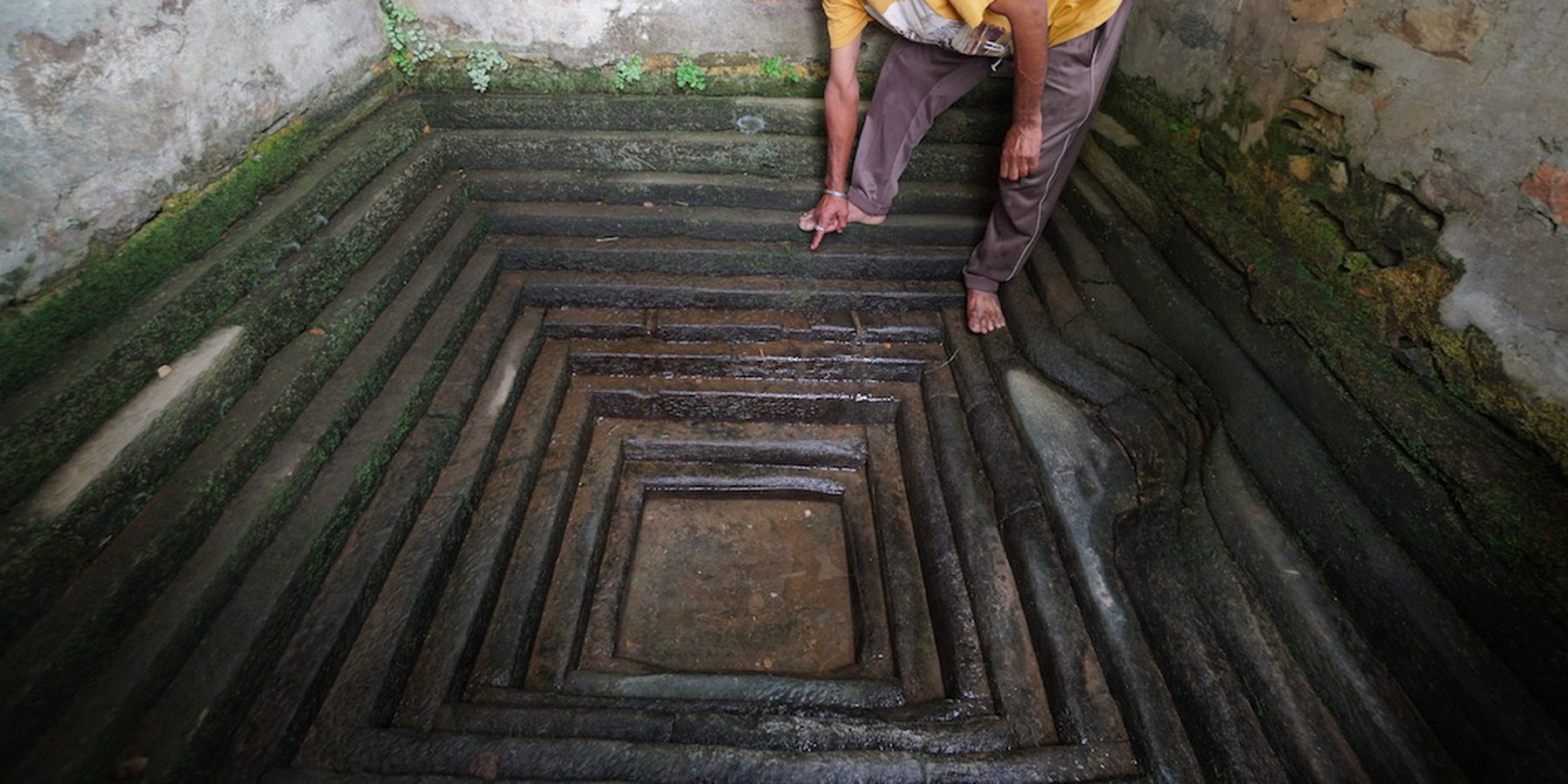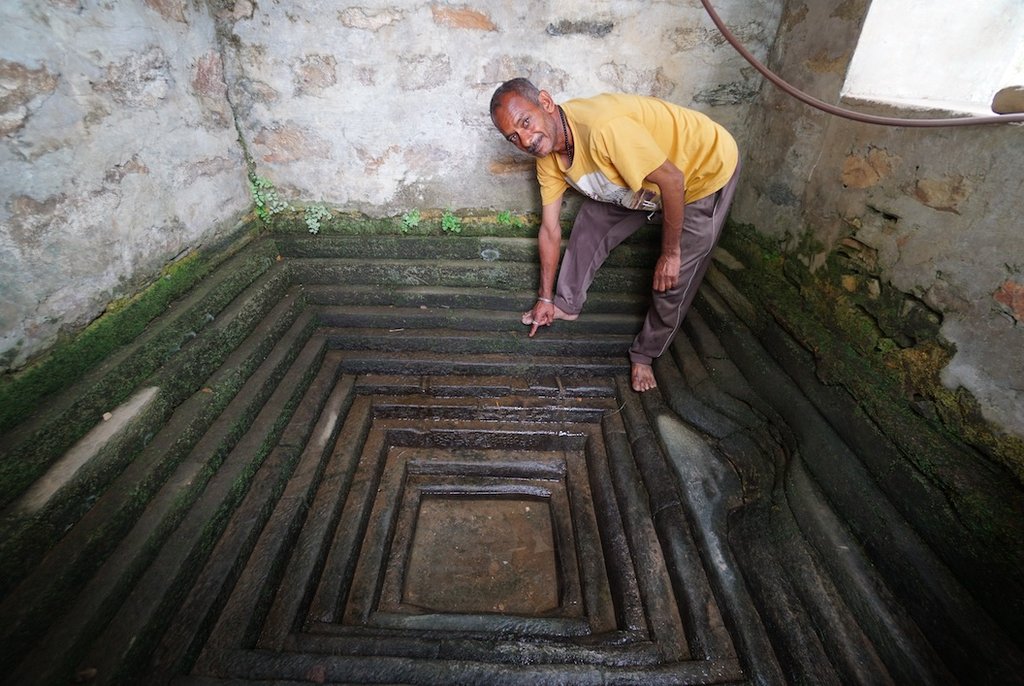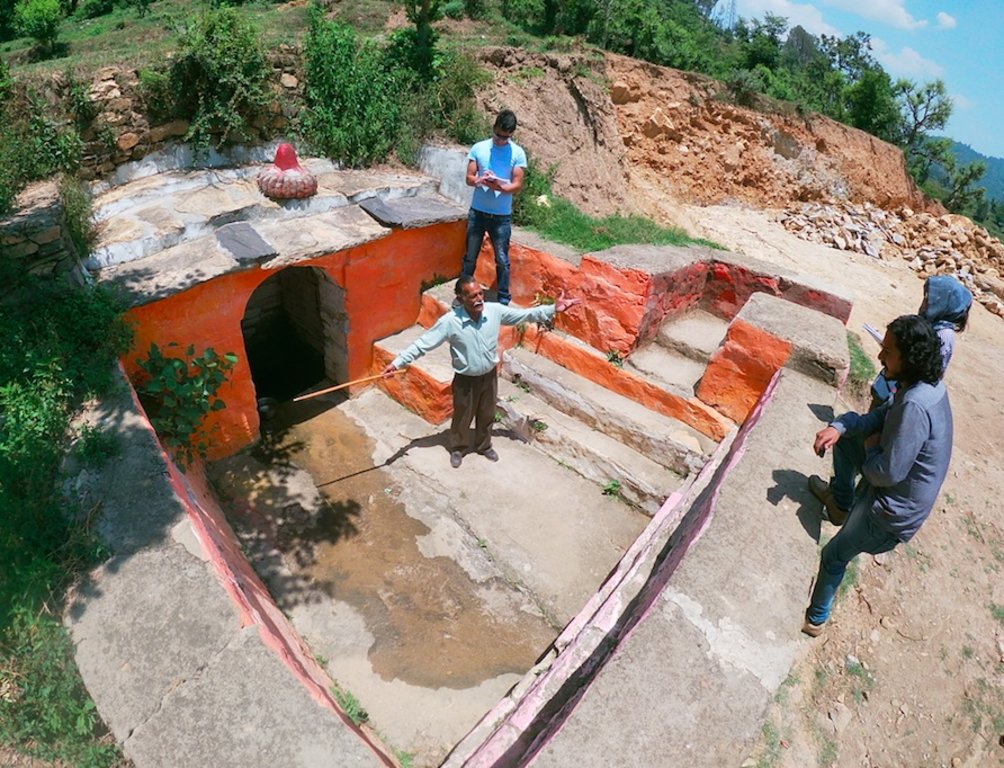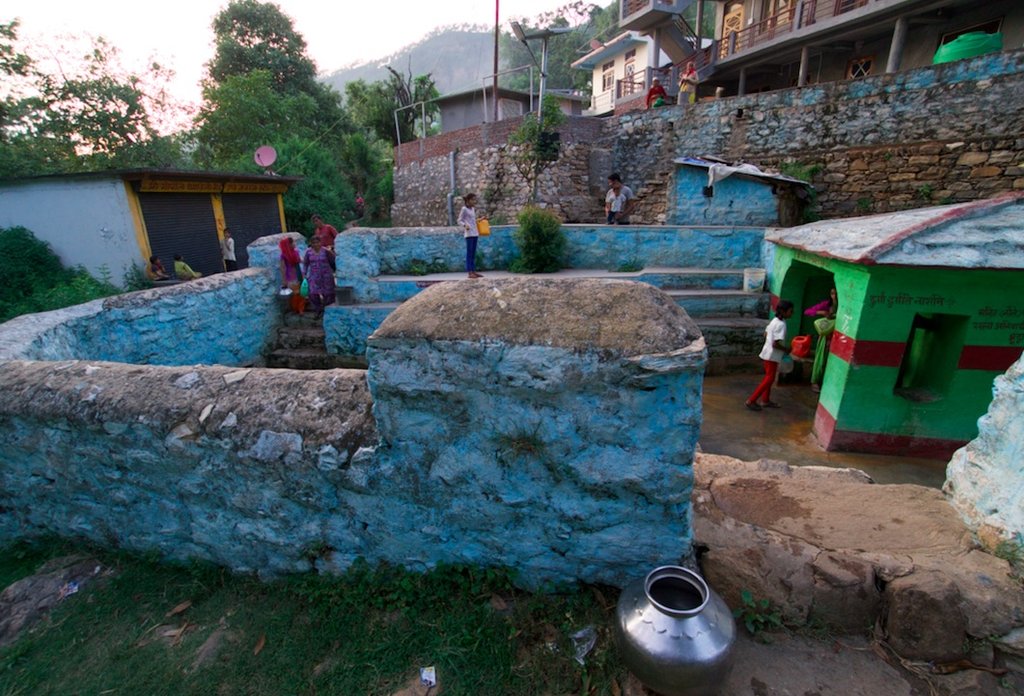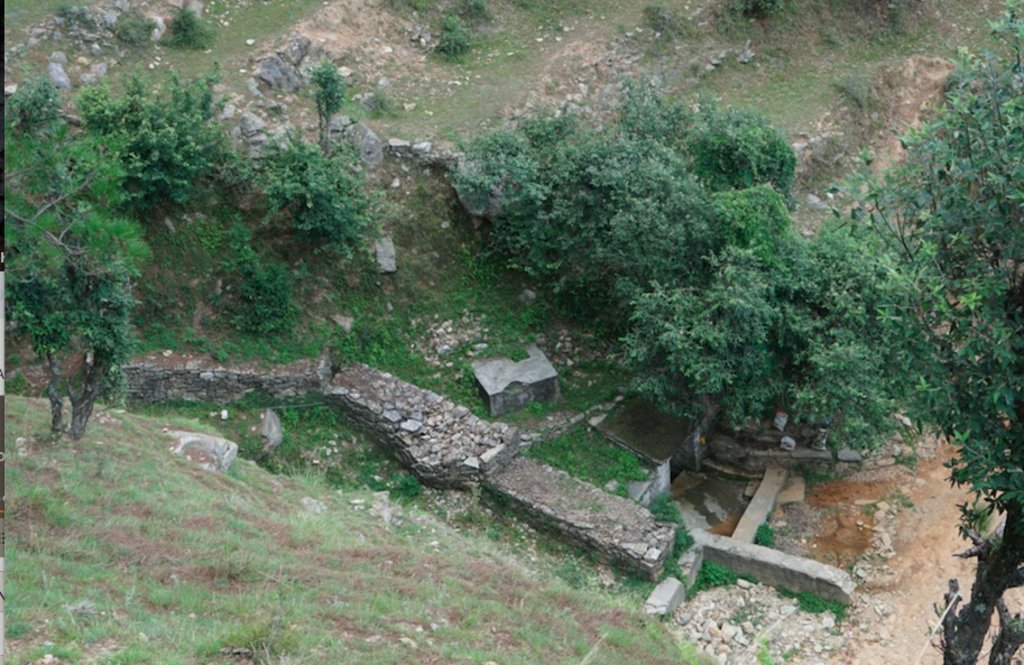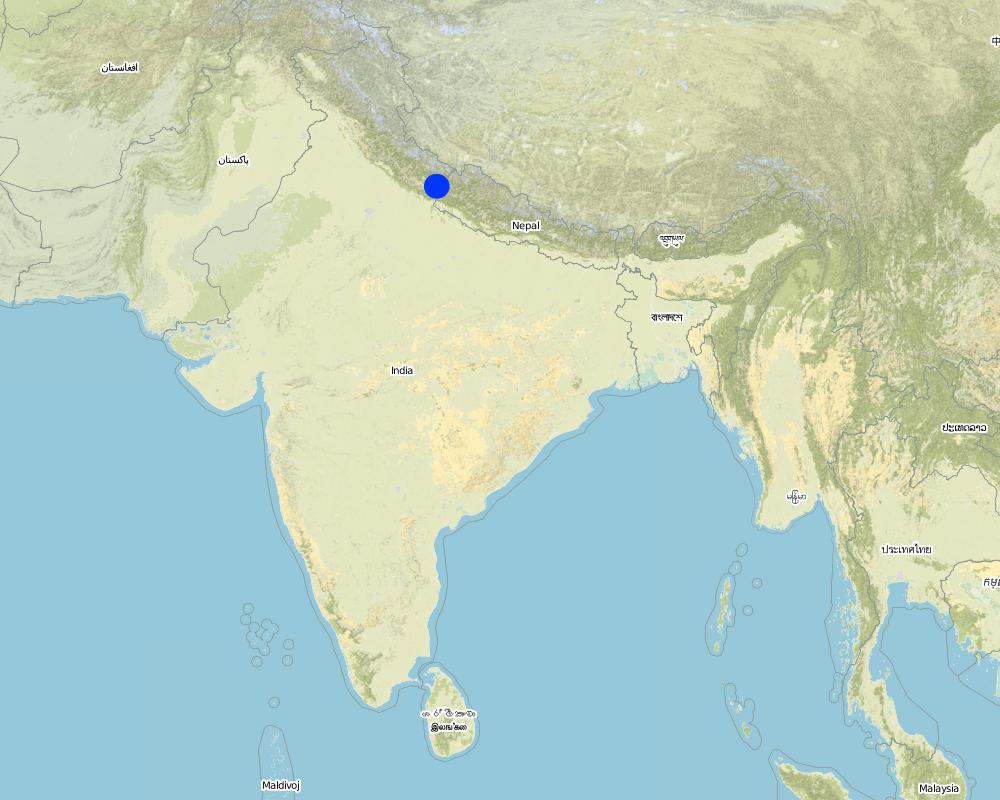Naula Management and Conservation [印度]
- 创建:
- 更新:
- 编制者: Jaclyn Bandy
- 编辑者: –
- 审查者: Hanspeter Liniger
Naula (depression well, indigenous water harvest technology)
approaches_5202 - 印度
查看章节
全部展开 全部收起1. 一般信息
1.2 参与方法评估和文件编制的资源人员和机构的联系方式
关键资源人员
土地使用者:
Jagdamba Joshi
+91 90120 89421
Sarpanch (Chief) of the Nakina Van Panchayat (Forest Council)
Nakina Village, Pithoragarh Bloc, Uttarakhand
印度
土地使用者:
Patni Pooran Chandra
+91 94113 48434 / +91 96395 41519
Digtoli Village
Digtoli Village, Pithoragarh Bloc, Uttarakhand
印度
有助于对方法进行记录/评估的项目名称(如相关)
Book project: where the land is greener - Case Studies and Analysis of Soil and Water Conservation Initiatives Worldwide (where the land is greener)有助于对方法进行记录/评估的机构名称(如相关)
ICIMOD International Centre for Integrated Mountain Development (ICIMOD) - 尼泊尔有助于对方法进行记录/评估的机构名称(如相关)
G.B. Pant Institute of Himalayan Einvironment & Development (G.B. Pant Institute of Himalayan Einvironment & Development) - 印度1.3 关于使用通过WOCAT记录的数据的条件
(现场)数据是什么时候汇编的?:
18/06/2019
编制者和关键资源人员接受有关使用通过WOCAT记录数据的条件。:
是
1.4 SLM技术问卷的参考
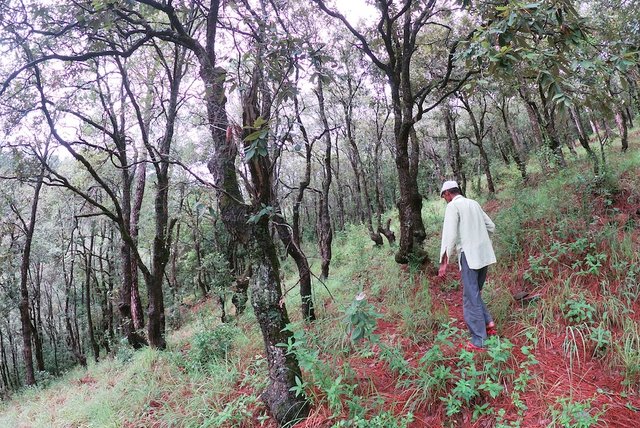
Broadleaf Plantations, Assisted Tree Regeneration and Fodder Nurseries … [印度]
Natural assisted regeneration of broadleaved species, a small oak plantation and a fodder nursery have been established in the Nakina community forest (intervention area: 10 ha), supporting fodder tree species such as Banj Oak and Falyaat, as well as various subtropical temperate fodder grass species. This has improved the livelihood …
- 编制者: Jaclyn Bandy
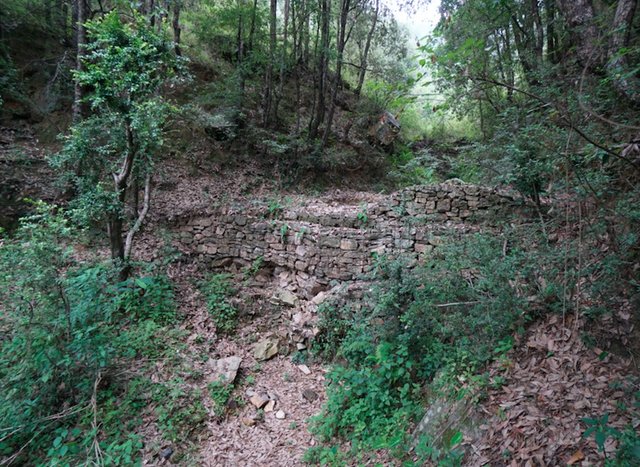
Stone Check Walls and Check Dams for Soil … [印度]
Stone Check Dams/Walls, Retainment Walls, and a Water Diversion Wall has been constructed in Nakina Village and Nakina Community Forest to help protect their settlements, agriculture land, forest land, and preserve the hilly landscape. These structures serve to reduce the runoff velocity (lowering the rate of erosion and gullying in …
- 编制者: Jaclyn Bandy
2. SLM方法的描述
2.1 该方法的简要说明
Naulas are shallow, four-sided stepped wells designed to collect water from subterranean seepages or springs and are used to meet domestic water needs by the local communities. Naula management and conservation encompasses a range of activities that preserve their structure and function.
2.2 该方法的详细说明
该方法的详细说明:
Naulas are imperative sources of natural seepage of drinking water and are considered the most important hydraulic structures to the villages in hill regions of Uttarakhand. They appear as a dry stone masonry structure, normally with a four-sided (rectangle or square) shape with stairs on all the sides and are commonly covered by stone slates and an erected wall on three sides. Since ancient times, water rituals are practiced within the communities and the water from these naulas have idols of various deities like the sun, moon, Earth, Vishnu, Ganesh etc. The main motive of keeping idols of gods and goddesses tied to the naulas is to preserve these structures from pollution and other harmful anthropogenic activities.
The efforts to preserve naulas include; building structural or vegetative barriers on the slope above to prevent physical damage, pollution from runoff and other erosive processes, establishing barriers of entry to deter wildlife and insects, initiating cleaning routines in the villages (scrubbing/disinfecting and clearing debris or weeds around the naulas).
The villages of Nakina, Digtoli, and Bhurmuni have carried out their own traditional measures to conserve these sacred structures and the water that flows into them. Sacred tree species like the peepal and banyan trees have been planted near naulas to signify its sanctity and to protect and shade it. To ensure the potability of a naula's water, biweekly cleaning regimes are undertaken. Structural measures such as check walls, check dams, and water channels have been made above the naulas. Additionally, wildlife entry is inhibited with cloth drapes that cover the naula's entrance, and some villages have established a protective enclosure around the naula.
Routine Naula conservation activities are taken up by those that collect the water, which include mainly the women and children. There is a water queue system in Nakina Village, in which people receive a specific time slot to take the water from the naula. This helps with keeping track of water use and promotes equitable use of water in the village. Other arduous tasks such as constructing the structural technologies include male participation. Monthly or bimonthly community meetings and daily checks on the Naulas help enforce the approach objectives. The villagers are are the sole stakeholders and take up full ownership and water user rights.
Generally, the older community members in these villages stress the need of Naula conservation and management to a greater degree. Members of the younger generation are less concerned and do not exhibit the same level of sensitivity, although they are aware of their importance to the community. The future effectiveness of the approach will depend on village participation and the level of dependency on the Naula for water during the dry season. With the drying of springs and increased use of pipe-schemes (though unreliable), external sources of water may replace this indigenous water harvesting technique.
2.3 该方法的照片
2.5 采用该方法的国家/地区/地点
国家:
印度
区域/州/省:
Uttarakhand
有关地点的进一步说明:
Digtoli, Pithoragarh Bloc
注释:
Villages: Digtoli, Nakina, Bhurmuni
Map
×2.6 该方法的开始和终止日期
若不知道准确的年份,请注明该方法的大致开始日期。:
50多年前(传统)
2.7 方法的类型
- 传统/本土
2.8 该方法的主要目的/目标
Maintenance and preservation of the indigenous water harvesting technology, the naula. By protecting this structure and the catchment area around it, the villages can protect their precious water resources and sustain a long-lasting tradition.
2.9 推动或妨碍实施本办法所适用的技术的条件
社会/文化/宗教规范和价值观
- 启动
Various religious ceremonies/rituals are still carried out around the naulas to this day. Lord Vishnu is associated with water in Hindu scriptures and mythology. Hence many naula have idols of Vishnu installed in them or sculpted on their stone walls. The need to revere and care for the naula is stressed by older generations.
- 阻碍
Due to shifting cultural dimensions, government or office jobs are considered to have a higher status than that of farmers in rural areas. These days rural youth have their minds set on getting a government or an office job. They are not willing to toil on their farms. This is severely straining the traditional systems of
managing common property resources
财务资源和服务的可用性/可得性
- 启动
Little external financial resources are required
- 阻碍
Less attention/investment is being directed to natural resources due to outmigration an off-farm employment opportunities
机构设置
- 阻碍
With better education and the increasing share of non-farm economy in the national economy, the potential for obtaining off-farm employment is growing rapidly. Non-farm employment (NFE) has affected traditional water management systems. NFE opportunities, particularly for rural males, have changed the traditional occupation structures in the villages. When a family's reliance shifts from agriculture to an off-farm source of income, its incentive to participate in the traditional voluntary chores required to maintain common property resources decreases. This reduces the supply of voluntary labor for tasks like the management and maintenance of naulas. Traditional sanctions against such households are less effective, thereby eroding local norms and authority. Families that are headed by women when the male head is away have difficulty in obtaining their rightful share of water. Interfamily disputes erupt on the return of the male heads, reducing the community's unity that is so essential for managing common property resources.
参与者的的协作/协调
- 启动
The approach is traditionally community driven, site specific and requires little to no external input from other actors outside of the village.
法律框架(土地使用权、土地和水使用权)
- 启动
There are no formal institutions or rules/written records of water rights and devices for regulating water use and their flow structures. In most traditional settings, water rights of individuals users are known, even if they are not formally recorded. In general all users are expected to participate in operation, maintenance and cleaning chores.
- 阻碍
In the absence of formal records, however, this can be variable depending on the village.
政策
- 启动
According to traditional law, communities have had the ownership, control and rights to these water resources. They have had the freedom to build a variety of water harvesting structures based on their experiential knowledge and have designed them to fulfill their needs. Although the Kumaon Water
Rules of 1917 transferred ownership of water resources to the state, the colonial government did not enact any specific legislation for water in the Uttarakhand region. As a result, village communities continued to look after their naulas and other water harvesting structures.
土地治理(决策、实施和执行)
- 启动
Traditional water collecting systems in Uttarakhand comprise a variety of community control methods. Their assortments started from the differences in the local circumstances. Many of these plans were
initially made by local leaders, dynasties and kings or by the prosperous people of the society. They display a diversity of technologies and minimal state intervention in water rights or management.
- 阻碍
Sometimes, these systems failed to ensure social justice. Caste discrimination, appears to be a common feature. In many locations, there are separate naulas for people of upper and lower castes. The
ones for the lower castes are usually smaller and unadorned structures by comparison. Care and maintenance is irregular and a large number are in a decrepit state.
了解SLM,获得技术支持
- 启动
工作量、人力资源可用性
- 启动
Naulas are typically close to the village (<500m), therefore combined community efforts make the workload and execution of this approach manageable, assuming their is collective participation.
3. 相关利益相关者的参与和角色
3.1 该方法涉及的利益相关者及其职责
- 当地土地使用者/当地社区
Nakina, Digtoli, and Bhurmuni Village
Local village authorities hold regular meetings with the people to organize, discuss and monitor the use/status of their water resources and naula structures/
3.2 当地土地使用者/当地社区参与该方法的不同阶段
| 当地土地使用者/当地社区的参与 | 指定参与人员并描述活动 | |
|---|---|---|
| 启动/动机 | 自我动员 | Village heads, community members, Nakina Van Panchayat (community forest council) |
| 计划 | 自我动员 | Village heads organize a Gram Sabha (a meeting of all villagers in each village council area) and fulfill their obligations in local resource decision-making with active community participation. |
| 实施 | 自我动员 | |
| 监测/评估 | 自我动员 | |
| 无 |
3.4 有关SLM技术选择的决策
具体说明谁有权决定选择要实施的技术:
- 仅限土地使用者(自主)
解释:
This is a traditional model of community-driven, decentralized water governance. It is both replicable and sustainable depending on the village's particular leadership, culture, tradition and politics.
明确做出决策的依据:
- 个人经验和意见(无记录)
4. 技术支持、能力建设和知识管理
4.1 能力建设/培训
是否为土地使用者/其他利益相关者提供培训?:
否
4.2 咨询服务
土地使用者有权使用咨询服务吗?:
是
指明是否提供了咨询服务:
- 在土地使用者的土地上
- 在固定中心
说明/注释:
There are several active organizations/ advisory services that are frequently engage with and are available to the communities. Some of these organisations include G.B. Pant, the Forest Department, and NGOs: Himalayan Sewa Samiti, CHEA, Swati Gramodyog Sansthan.
4.3 机构强化(组织发展)
是否通过这种方法建立或加强了机构?:
- 是,适度
具体说明机构的强化或建立程度:
- 本地
说明机构、角色和职责、成员等。:
Nakina village and Nakina Van Panchayat (community forest council) in particular have strengthened their relationships with external institutions and have been receptive to new projects for sustainable water management and natural resource use. This has increased involvement of the community and strengthened approach participation. Additionally, it has increased awareness and the need for spring restoration interventions and sustainable land use within the catchment areas of the springs/naulas.
具体说明支持类型:
- 财务
- 能力建设/培训
4.4 监测和评估
监测和评估是该方法的一部分吗?:
是
注释:
Regular monitoring by the village community
若是,该文件是否用于监测和评估?:
否
4.5 研究
研究是该方法的一部分吗?
否
5. 融资和外部物质支持
5.1 该方法中SLM组成部分的年度预算
如果不知道准确的年度预算,请给出一个范围:
- < 2,000
5.2 为土地使用者提供财政/物质支援
土地使用者是否获得实施该技术的财政/物质支持?:
否
5.3 对特定投入的补贴(包括劳动力)
如果土地使用者的劳动力是一项重要的投入,那么是不是:
- 自愿
5.4 信用
是否根据SLM活动的方法给予信用值?:
否
5.5 其它激励或手段
是否有其他激励措施或工具用于促进SLM技术的实施?:
是
如果是,请具体说明:
The World Bank aided Uttarakhand Decentralized Watershed Development Project (GRAMYA) implemented by Watershed Development Directorate of Uttarakhand
Government. It is operating since 2005 with the aim to mitigate water problems and addressing issues of other natural resources, with emphasis on women participation.
NITI Aayog (National Institution for Transforming India), Government of India has recently launched a National Programme on Regeneration of Springs in the Himalayan Region 2017).
6. 影响分析和结论性陈述
6.1 方法的影响
该方法是否有助于当地土地使用者,提高利益相关者的参与度?:
- 否
- 是,很少
- 是,中等
- 是,支持力度很大
Increased awareness of naula importance; enhanced collaborative water conservation and use within the community
这种方法是否有助于基于证据的决策?:
- 否
- 是,很少
- 是,中等
- 是,支持力度很大
Traditional approaches encompass ecosystem thinking, and therefore good practices such as planting trees above the naula and creating a favorable environment in the catchment area have been adopted by these communities for many generations. Though there has been improvements in infrastructure, officially provided water supply systems have either not reached the remote rural villages or where provided are unreliable, poorly maintained, and not the preferred source of drinking water.
该方法是否帮助土地使用者实施和维护SLM技术?:
- 否
- 是,很少
- 是,中等
- 是,支持力度很大
Increased sensitivity to the importance and impact of the surrounding ecosystem to the springs/naula function.
该方法是否提高了SLM的协调性和成本效益?:
- 否
- 是,很少
- 是,中等
- 是,支持力度很大
The approach supported community ecosystem-based thinking and has extended to interventions with the Nakina Van Panchayat (community forest council)
该方法是否调动/改善了使用财务资源实施SLM的途径?:
- 否
- 是,很少
- 是,中等
- 是,支持力度很大
Active participation of the community and strong organizational qualities have helped extend their network and resource base
该方法是否提高了土地使用者实施土地管理的知识和能力?:
- 否
- 是,很少
- 是,中等
- 是,支持力度很大
This approach increased engagement and refined attention to their main drinking water resources. Because spring discharge is decreasing, people have started to extend interventions in the microwatersheds or catchment areas of the springs for ground water recharge. This includes establishing plantations, avoiding overgrazing in the forests, and building recharge ponds and trenches.
该方法是否提高了其他利益相关者的知识和能力?:
- 否
- 是,很少
- 是,中等
- 是,支持力度很大
Increased the combined interest of village-institution cooperation to understand the hydrogeological science behind spring recharge and develop recharge schemes to improve water security.
该方法是否建立/加强了机构、利益相关者之间的合作?:
- 否
- 是,很少
- 是,中等
- 是,支持力度很大
ICIMOD, G.B. Pant, the Forest Dept., and local NGOS are improving the merging of their efforts when working with particular communities that are open and curious to new projects and scientific technologies.
该方法是否缓解了冲突?:
- 否
- 是,很少
- 是,中等
- 是,支持力度很大
There is a systematic organization of naula use and care in the villages, which is generally obeyed and thus conflict is avoided.
该方法是否有助于社会和经济弱势群体?:
- 否
- 是,很少
- 是,中等
- 是,支持力度很大
Upper caste members in the villages continue to determine social inclusion/exclusion with access to water sources. The culture excludes the Dalits in Chuni (lower castes) from accessing or using any Naula in the village except the one that is assigned as theirs. Despite this, the naulas of the lower caste are still considered important for management and conservation.
该方法是否改善了性别平等并赋予女性权力?:
- 否
- 是,很少
- 是,中等
- 是,支持力度很大
Improved the realization and need for woman empowerment in decision-making for the water resource use and management. Women in Nakina village feel comfortable to speak up and voice their concerns in group discussions. However, when the water in the naulas reduces, women are still blamed for accessing the spring in an "impure" condition (when menstruating) and are consequently banned from using the naula and sent to live in small huts outside the domains of the main house.
该方法是否鼓励年轻人/下一代土地使用者参与SLM?:
- 否
- 是,很少
- 是,中等
- 是,支持力度很大
The approach has gained momentum for participation in preservation and restoration of naula structures. If water scarcity persists, the next generation can't expect to make a sustainable livelihood in their home villages.
该方法是否改善了粮食安全/改善了营养?:
- 否
- 是,很少
- 是,中等
- 是,支持力度很大
Increased available water supply for small vegetable patch watering and water for livestock
该方法是否改善了供水和卫生条件?:
- 否
- 是,很少
- 是,中等
- 是,支持力度很大
Decreased risks of pollution from run off, water-born diseases and water availability
该方法是否提高了土地使用者适应气候变化/极端情况和减轻气候相关灾害的能力?:
- 否
- 是,很少
- 是,中等
- 是,支持力度很大
Decreased effects and damage of extreme weather events on naula structure (e.g. reduced impact of erosion and pollution from run-off, protection from fire)
6.2 土地使用者实施SLM的主要动机
- 减少土地退化
The people are aware of the implications that land degradation have on their water resources.
- 减少工作量
Preservation and protection of a naula results in less work than repairing a physically damaged naula
- 规章制度(罚款)/执行
There is a strictly enforced rotation system to use the Naula at given times in the dry season (morning: 7-9am), (evening: 6-8pm). Penalties result for violating these rules.
- 声望、社会压力/社会凝聚
The approach builds more equity into the community
- 加入运动/项目/团体/网络
With collective ownership of natural resources, villagers build better relationships among neighbors. With more resources and access to water, people are were willing to share and address the needs of others.
- 环境意识
- 习俗和信仰,道德
Lord Vishnu is worshipped where naulas are built, and thus the water contained within these nauals is considered a deity.
- 提高SLM知识和技能
- 美学改进
- 冲突缓解
Responsible and respectable use of this precious resource is essential for conflict mitigation
6.3 方法活动的可持续性
土地使用者能否维持通过该方法实施的措施(无外部支持的情况下)?:
- 是
若是,请说明如何维持:
The community is and has historically been dependent on these water harvesting structures. What has been implemented through the approach needs to be perpetuated for generation to come, along with management of the forests aand other natural resources within the catchments of the springs.
6.4 该方法的长处/优点
| 土地使用者眼中的长处/优势/机会 |
|---|
| Improved awareness and action in the community to preserve Naulas; daily users incorporate habitual care and the naulas are well-preserved, clean and respected. Water quality is improved. |
| Increased cohesion of village members and inclusion of women participation with water use and other natural resource management. This is especially recognized in Nakina village. |
| Aesthetic of area is improved, and this is important for spiritual purposes within the communities. Rituals associated with water and naula more appreciated and celebrated. Enhancement of these cultural aspects improves harmony and connectedness within social groups and to nature. |
| 编制者或其他关键资源人员认为的长处/优势/机会 |
|---|
| Improved understanding of the Naula's respective catchment area (origin of water source/storage) and the need for SLM practices upstream in springsheds |
| Maintains and strengthens social order and awareness of water resource use/requirements |
6.5 该方法的弱点/缺点以及克服它们的方法
| 土地使用者认为的弱点/缺点/风险 | 如何克服它们? |
|---|---|
| If naulas get severely damaged there is hardly anyone in the village today with knowledge of how these structures were constructed and the engineering techniques behind them. | Consultations with older members of the community and with nearby villages could be organized. This would effectively be combined with interventions from institutions like G.B. Pant, who can also combine research efforts on the geohydrology of springs an engineering methods to improve naula/spring discharge. |
| 2 years ago, Nakina village members used bleaching powder to clean the naula. A small amount of bleaching powder (2 teaspoons) was suggested for each Naula (approx Volume: 1mx 1m x 0.8m), however there is no strict monitoring of the water quality. | Now Nakina has recently switched to chlorine tablets, which make measurements easier. They use them about once a month or when there is some incidence of pollution. Traditional methods of naula disinfection could be reintegrated in the cleaning regime (e.g. using the leaves of Amla: Emblica officinalis Gaertn and Neem, Azadirachta indica A Juss) |
| There are times when the water overflows from the confines of the naula structure. | Overflow can be harvested in earthen/ polyethylene ponds or recharge trenches below. |
| 编制者或其他关键资源人员认为的弱点/缺点/风险 | 如何克服它们? |
|---|---|
| In the absence of documentation about the engineering and the science behind the traditional water management systems, it is very difficult to revive these structures once they have been neglected. | Studies that integrate land use changes, traditional knowledge on water management systems, hydrogeological aspects of springs, and potential structural/biological interventions for spring revival need to be implemented with the help of coordinated actors and stakeholders across all agency levels. |
| There are sometimes pipes connected to the naulas leading to reservoirs (storage tanks). The pipes or taps of these reservoirs often have leaks. The community trouble-shoots this issue by plugging the open taps with a fitted wooden stick or ball of plastic trash. There is still significant leakage. | Pipes need to be monitored and repaired; open taps need to be properly plugged (perhaps with a rubber stopper). Twist-taps need to be repaired, and if this is not possible then the leaking droplets can be harvested with a bucket. |
| There is still discrimination of water use within the caste system. Dalits remain excluded from authorities that make decisions about water at the village level. Similarly, women in many villages are still excluded from any decision-making. Both groups are perceived to be highly susceptible in "spoiling" the water collected from nauala structures. | Deep-rooted caste and gender inequities are not simply erased at the local level, despite the policy efforts to improve economic and political mobility within these groups. To equitably improve access to water for the Dalits and women, the root causes of the determinants of social inequity need to be identified, exposed and addressed locally. Nakina village is taking strides to incorporate women and Dalits into decision making processes, as they are the ones remaining in the village. Nakina recognizes this need to involve these formerly excluded groups, as the phenomenon of unidirectional outmigration will simultaneously amplify the necessity of group-cohesion and dedication for sustainable land/resource management . |
7. 参考和链接
7.1 方法/信息来源
- 实地考察、实地调查
FGD's in Nakina, Digtoli, ad-hoc interviews in Bhurmuni
- 与土地使用者的访谈
Village head of Digtoli, Naikina, Bhurmuni
- 与SLM专业人员/专家的访谈
G.B. Pant (1) Dr. Ranbeer Rawat
7.2 参考可用出版物
标题、作者、年份、ISBN:
Traditional Knowledge of Water Management, Rawat A.S., Sah R. 2009, Indian Journal of Traditional Knowledge, Vol. 8(2) pp. 249-254
可以从哪里获得?成本如何?
http://nopr.niscair.res.in/bitstream/123456789/3942/1/IJTK%208(2)%20249-254.pdf
7.3 链接到网络上可用的相关信息
标题/说明:
Report of Working Group I Inventory and Revival of Springs in the Himalayas for Water Security
URL:
https://niti.gov.in/writereaddata/files/document_publication/doc1.pdf
链接和模块
全部展开 全部收起链接

Broadleaf Plantations, Assisted Tree Regeneration and Fodder Nurseries … [印度]
Natural assisted regeneration of broadleaved species, a small oak plantation and a fodder nursery have been established in the Nakina community forest (intervention area: 10 ha), supporting fodder tree species such as Banj Oak and Falyaat, as well as various subtropical temperate fodder grass species. This has improved the livelihood …
- 编制者: Jaclyn Bandy

Stone Check Walls and Check Dams for Soil … [印度]
Stone Check Dams/Walls, Retainment Walls, and a Water Diversion Wall has been constructed in Nakina Village and Nakina Community Forest to help protect their settlements, agriculture land, forest land, and preserve the hilly landscape. These structures serve to reduce the runoff velocity (lowering the rate of erosion and gullying in …
- 编制者: Jaclyn Bandy
模块
无模块


